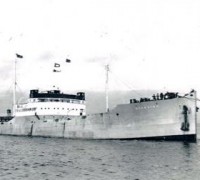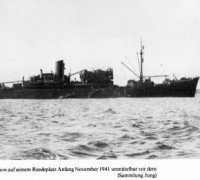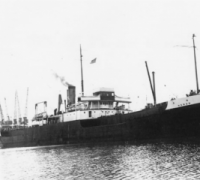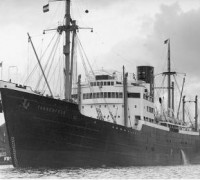- SHIPS TANKERS
11)SUPPLY SHIP REGENSBURG
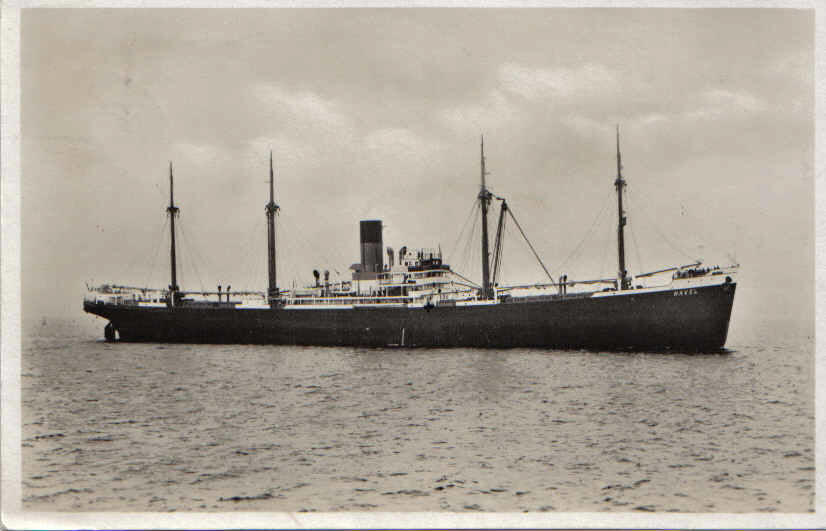
Tanker Regensburg seen as former Trave sister ship Havel Photo Trave (ship, 1928) - Wikiwand
Built 1927
Commissioned March 1928
Tonnage 8,068 GRT/11,654 DWT
Length 506,7 ft
Beam 60,2 ft
Draught 28,6 ft
Propulsion 2 Eight cylinder Diesel Engines at 7,355 Kw
Speed 16,5 kt
Complement 50
The Regensburg launched as TRAVE in 1927, was rebuilt, lengthened and given new engines in 1938, at which time her name was changed to REGENSBURG.
When war broke out in 1939, the ship was in East Asia and was used by the Japan stage for supply trips for German auxiliary cruisers . In 1943, Regensburg was supposed to break through to its homeland with a load of goods essential to the war effort. The British light cruiser HMS Glasgow landed it on Denmark Strait and sank itself when it approached on March 30, 1943. Of the 118 men on board the blockade breaker , the cruiser was only able to save six alive.The Regensburg became the Navy - stage assigned to Japan, where the main objective to support the pre-discharged into the Pacific in 1940 auxiliary cruiser Orion and Comet was. She left Yokohama on September 27, 1940 with 2800 tons of heating oil and provisions and ran to the Ailinglapalap atoll of the Marshall Islands , where she waited for the Orion until October 10.
Since the Weser of the NDL, which was also intended to serve as a supplier, had been seized by a Canadian auxiliary cruiser just a few hours after leaving Manzanillo (Mexico) , the Orion and the Regensburg ran immediately on to Lamotrek in the Carolines to take the Komet and her out there Japan sent supplier to meet Kulmerland . On October 18, the four ships met, all superficially disguised as Japanese. The Regensburg then ran back to Japan to procure urgently needed spare parts for the Orion , while the three other ships in the formation searched the South Seas.
On December 20, 1940, Regensburg left Yokohama again to supply the Orion with provisions and the necessary spare parts at Lamotrek . The former Norwegian tanker Ole Jacob was waiting for the Orion with her . This pinch of Atlantis had been sent to Japan with its cargo of aviation fuel and important documents . In exchange for the documents and the gasoline, the tanker was now loaded with fuel for the German auxiliary cruisers and other supplies. The Regensburg gave its supplies to the Orion and the Ole Jacob and left the meeting point immediately after the New Year in order to procure more goods in Japan.
On January 12, 1941, she left Japan for a third time with supplies and water for the Orion , which was now near Maug in the north of the Mariana Islands , in order to carry out a comprehensive overhaul far away from the shipping lanes. Their future provider was Ole Jacob . The Münsterland from the Japan stage also arrived with fresh water and food , which also brought a new Nakajima E8N -1 aircraft , as the old aircraft could no longer be used. The Orion and Ole Jacob left Maug on February 6, while the two providers stayed behind.
The Regensburg then ran to Dairen , where it was equipped to break the blockade. She left with a load of raw rubber and grease under Captain Harder Dairen on May 5, 1941 and arrived on June 27 as the second blockade breaker from Japan after the Warmia in Bordeaux in the German-occupied France.
In October she moved to Nantes , where she was overtaken to run back to Japan as a blockade breaker. The bridge was lightly armored and additional cabins were installed for the crew. In February 1942, she left Bordeaux for the Far East with a load of turbines, dyes and other goods important to Japan. On the way, the Regensburg supplied the auxiliary cruiser Thor , which left on its second voyage in January . She reached Yokohama on July 7, 1942 as the eighth Navy Service ship sent from Europe.
The first supply of the Thor from Regensburg took place from March 24th to 27th north of Tristan da Cunha shortly after the first success of the auxiliary cruiser. It was not until May 4 that the ships met again in the southern Indian Ocean. The Regensburg gave supplies to the auxiliary cruiser and took 162 prisoners from the five victims of Thor so far. The blockade breaker did not use his possible maximum speed on the journey to save fuel; The maximum possible speed was only used in critical sea areas.
On May 10, the Thor succeeded in capturing the 7,130 GRT Australian combi ship Nankin , which was on its way to Bombay with 162 passengers and 180 crew members . The ship was named Leuthen, and all the prisoners got the prize. The supplies of the summoned Regensburg were distributed, and then the Regensburg was released to Japan with the prize.
The blockade breaker who arrived there in July was unloaded in Yokohama and then went to Kobe to pick up whale and coconut oil for the journey home. On September 14, 1942, Regensburg began its return journey to Europe. Balikpapan was called to receive fuel and then to Batavia , where quinine was added to the cargo. The last port in the Japanese sphere of influence was Singapore , where the holds were filled with raw rubber and zinc ore . The ship left there on October 9th and went through the Sunda Strait into the Indian Ocean. There the Regensburg was attacked by the US submarine USS Searaven.
One of the five torpedoes hit in the forecastle. With the front cargo holds full, the Regensburg managed to reach Batavia, where she entered with practically no freeboard. Emergency repairs were carried out there with divers and the ship then went back to Singapore, where it was unloaded and repaired. The cargo was taken over by the Rhakotis , which however failed to break through to southern France.
The last ride of Regensburg
After the repair, the Regensburg took on another 9,000 tons of cargo (4500 tons of raw rubber, 3785 tons of coconut and whale oil, 500 tons of tin, 100 tons of tungsten ore, 100 tons of tea) and left Singapore on January 30, 1943 with 116 men on board. In addition to the usual crew, former crew members of the Uckermark and the Doggerbank were on board, as well as a marine doctor and 15 marines for the existing on-board weapons: The Regensburg had a typical British 4-inch gun at the stern and two British 40 mm Bofors anti-aircraft guns in the wings of the bridge. There were also two fog canisters at the stern. The ship called at Batavia, took over 15 tons of quinine there and left on February 6, 1943 together with the Weserland (ex Ermland ). However, this was soon left behind.
On February 28, the ship in the South Atlantic was ordered to sail through the Denmark Strait and along the Norwegian coast to Stettin . On March 22nd, he was given a meeting point with U 302 , with which Regensburg met on the following day. The submarine gave the blockade breaker a radio monitoring device of the Metox type with two operators as well as maps and identification symbols for the rest of the voyage.
On March 28, the Regensburg entered the Denmark Strait and increased her speed to 15 knots. At dawn on March 30, a light grenade exploded in front of the ship and the Regensburg was immediately taken under cover under artillery fire . The commander signaled that he would stop and ordered the sinking and evacuation of Regensburg . But only one lifeboat could be successfully brought into the freezing water. The crew tried to save themselves on rafts. The light cruiser HMS Glasgow sank the German ship at Coordinates 66º 41'N, 25º 31'W with artillery and a torpedo. Only six of the 118 men on board the Regensburg could be rescued from the rough seas. The success of the Glasgow was due to the British radio reconnaissance ( Ultra ).
By Wikipedia
Chronology
Sep 27 1940. Regensburg sailed from Yokohama for a rendezvous with Raider Orion and suply ship Kulmerland and Raider Komet at Lamotrek Atholl in Carolines
Oct 10 1940. Regensburg anchors at Ailinglapalap Atholl in the Marshals Is. In two days she was replenished with 3,000 tons of fuel and other provisions from Japanese produce.
Oct 18 1940. Regensburg ran back to Japan in search of badly needed spare parts for Raider Orion.
Dec 20 1940. Regensburg left Yokohama for a rendezvous at Lamotrek Atholl with Raider Orion, having reached the area on Dec 30. Regensburg left on Jan 1 1941 for Japan.
Jan 12 1941. Regensburg left Japan for a third time with supplies for Raider Orion, this time for a rendezvous at Maug Island North of Marianas.
Jan 18 1941. Regensburg arrives and supplies Raider Orion with fresh fruits, vegetables and 100 tons of drinking water
Feb 06 1941. Regensburg left Maug Island for Dairen, China to get a load of rubber for Bordeaux, France.
May 5 1941. Regensburg left Dairen having reached Boardeaux on Jun 27 1941.
Feb 1942. After a long period of refitting at Nantes, Regensburg moved to Bordeaux and once again left harbor for the Far East. On the way Regensburg supplied raider Thor. She reached Yokohama on Jul 27 1942.
Mar 24/27 1942. Regensburg rendezvoused with Raider Thor in South Atlantic North of Tristan da Cunha Island.
May 4 1942. Regensburg rendezvoused with Raider Thor in South Indian Ocean. Regensburg then took 162 POW from the raider.
May 10 1942. Regensburg rendezvoused with Raider Thor when supplies from captured 7,130 ton Australian ship Nankin were transferred to the raider. Then Regensburg was released to take to Japan as prize the captured Nankin.
May 31 1942. Regensburg rendezvoused with supply ship Dresden in Indian Ocean when took on fuel from Dresden. Also Regensburg transferred 104 survivors from Nankin and one crewmember from British merchant Willesden.
March 22 1943. Regensburg rendezvoused with U-302 in the South Atlantic.
Below the detailed report provided by US Navy about the operational life and demise of Supply ship Regensburg.
